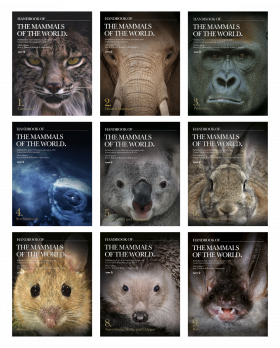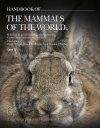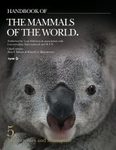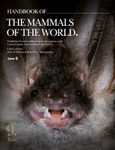World / Checklist Flora / Fauna
By: Don E Wilson(Editor), Thomas E Lacher, Jr.(Editor), Russell A Mittermeier(Editor), Toni Llobet François(Illustrator)
988 pages, 60 plates with colour illustrations; 737 colour photographs, 850 colour distribution maps
![Handbook of the Mammals of the World, Volume 6: Lagomorphs and Rodents I Handbook of the Mammals of the World, Volume 6: Lagomorphs and Rodents I]()
Click to have a closer look
About this book
Contents
Customer reviews
Related titles
About this book
Rats and mice and their relatives in the order Rodentia make up almost half of the species of mammals. Because of this, Lynx polled their readers and the overwhelming positive response was to produce two volumes treating Rodents. Volume 6 will include all of the families of rodents other than Cricetidae and Muridae, plus the order Lagomorpha, which includes rabbits and pikas. This radiation includes some 35 families, which have spread around the globe, occupying every continent except Antarctica, and countless islands in all major oceans. As usual, the text includes up-to-date information on every species, and each species is illustrated. Each family account includes color photographs documenting a variety of behaviors of these diverse and interesting mammals.
This volume also includes a Special Chapter: An overview of rodents, including chapters on morphology, taxonomy, and evolutionary history; why rodents are studied; and tools for studying them.
Families covered in Volume 6:
ORDER LAGOMORPHA:
2 families, 11 genera, 92 species
ORDER RODENTIA:
Suborder Castorimorpha: 3 families, 13 genera, 109 species
Suborder Anomaluromorpha: 2 families, 4 genera, 9 species
Suborder Hystricomorpha: 17 families, 71 genera, 274 species
Suborder Sciuromorpha: 3 families, 69 genera, 314 species

Volumes 1-9 can also be bought together.
Contents
Family Ochotonidae (Pikas) - Andrey Lissovsky
Family Leporidae (Hares and Rabbits) - Stéphanie Schai-Braun & Klaus Hackländer
Family Castoridae (Beavers) - Peter Busher
Family Heteromyidae (Pocket Mice, Kangaroo Mice and Kangaroo Rats) - David Hafner
Family Geomyidae (Pocket Gophers) - Mark Hafner
Family Anomaluridae (Anomalures) - Stephen Jackson
Family Pedetidae (Spring Hares) - Raquel López-Antoñanzas
Family Ctenodactylidae (Gundis) - Raquel López-Antoñanzas
Family Diatomyidae (Kha-nyou) - Paula Jenkins
Family Hystricidae (Old World Porcupines) - Erika Barthelmess
Family Thryonomyidae (Cane Rats) - Raquel López-Antoñanzas
Family Petromuridae (Dassie Rat) - Raquel López-Antoñanzas
Family Heterocephalidae (Naked Mole-rat) - Bruce Patterson
Family Bathyergidae (African Mole-rats) - Rodney Honeycutt
Family Erethizontidae (New World Porcupines) - Erika Barthelmess
Family Cuniculidae (Pacas) - Rafael Samudio Jr.
Family Caviidae (Cavies, Capybaras and Maras) - Thomas Lacher Jr.
Family Dasyproctidae (Agoutis and Acouchys) - Thomas Lacher Jr. & Jessica Gilbert
Family Chinchillidae (Viscachas and Chinchillas) - Angel Spotorno & Pablo Valladares
Family Dinomyidae (Pacarana) - Michael Mares & Janet Braun
Family Abrocomidae (Inca Rats and Chinchilla Rats) - Louise Emmons
Family Ctenomyidae (Tuco-tucos) - Thales Freitas
Family Octodontidae (Viscacha Rats, Degus, Rock Rats and Coruro) - Agustina Ojeda
Family Echimyidae (Hutias, Coypu South and American Spiny-rats) - Pierre-Henri Fabre, Jim Patton & Yuri Leite
Family Aplodontiidae (Mountain Beaver) - Samantha Hopkins
Family Sciuridae (Tree, Flying and Ground Squirrels, Chipmunks, Prairie Dogs and Marmots) - John Koprowski, Emily Goldstein, Kendell Bennett & Calebe Pereira
Family Dormice (Gliridae) - Mary Ellen Holden-Musser, Rimvydas Juškaitis & Grace Musser
Customer Reviews (2)
-
Breath-taking series.
By
Neville
17 Dec 2016
Written for Hardback
I would never have imagined that a work such as the
Handbook of the Birds of the World would be created. I had several times thought how wonderful that would be. Then the idea of a mammals of the world seemed even more challenging, and less likely. Perhaps two thirds of the way into the series on mammals, i remain astounded & thrilled by every aspect of these incomparable volumes. The amount of information on each & every species is remarkable & invaluable, the maps a treasure (they could be a fraction bigger, but that would be impractical, and unreasonable to expect), and the illustrations are spectacular, not only for their standard, but also for quantity – every species is illustrated, and the most significant subspecies too. I would never have dreamed that this would be accomplished at all, but to do so in the order Rodentia is a super-human achievement, and every illustration a treasured masterpiece of accuracy. I cannot praise this series highly enough, and i do not have the words to express my gratitude to all involved in its publication, especially artist Toni Llobet.
4 of 4 found this helpful
-
Was this helpful to you? Yes No
-
An essential reference
By
Gehan de Silva Wijeyeratne
12 Apr 2020
Written for Hardback
In this review, I have covered two volumes together as the rodents which are the bulk of the content are split into two parts within the two volumes. Volume 6 in the Handbook of the Mammals of the World series covers Lagomorphs (hares, rabbits etc.) as well as the first part of Rodents. Volume 7 covers the rest of the rodents. I have reviewed some of the volumes in this series before. But every time I receive a new volume, I am amazed by the scale and ambition of this epic project. When you hold one of these books, you are holding a piece of zoological history as it surpasses all previous efforts to comprehensively document and illustrate the extant mammals of the world.
Admittedly, lagomorphs and rodents do not excite the public imagination in the way big cats and primates do. If at all, rodents suffer from bad press thanks to the House Rats and Brown Rats in our villages and towns. But these undesired rodents belong to just one family of a significant mammalian radiation. The rodents represent one of the most species-rich mammalian groups which unfortunately are out of sight and mind for most people. The stunning imagery in these volumes may help to convince some that even the rats and mice can be likeable. If it were not for our association of them with disease, many of them would be accepted as looking rather endearing. Perhaps it is just as well for their conservation that other than for a few exceptions they are not popular as pets. As it is, 89 species are noted as being consumed, in the excellent essay in volume 6 introducing the evolution, phylogeny, ecology and conservation of the lagomorphs and rodents.
The series is underpinned by strong science and in particular an effort to understand and articulate evolutionary relationships as understood at present, using molecular phylogenetics. They complement field guides which necessarily have to be concise and lightweight. Last year, I was in the USA and using a field guide to mammals of North America. I was aware that the rats and mice in the USA were in an entirely different family (Cricetidae) to the family of the rats and mice I was familiar with (Muridae) when I grew up in Sri Lanka. The family relationship charts in the series are a great help in understanding these family relationships which in everyday parlance are seen as one homogenous group of rats and mice. A good example of a chart is the one for the Cricetidae on page 205 in volume II. It illustrates in a very simple way how the family comprises five subfamilies within which are 27 tribes. The summary text box contains details that these tribes hold 765 species in 142 genera. The summary text box also contains a distribution map which makes clear the family is not just ‘New World’ (although some tribes will be confined to the New World) but extends across Eurasia to include species such as voles which I am familiar with from my other home in Britain.
The two volumes follow the standard format for the series. A few preliminaries are followed by expansive family introductions which are grouped under standard categories including Systematics, Morphological Aspects, Habitats, General Habits, Communication, Food and Feeding, Breeding, Movements, Home Range and Social Organisation, Relationships with Humans and finally Status and Conservation. These sections are interspersed with stunning images of a generous size afforded by the larger encyclopaedia size of the pages. Some images occupy a full page combining a coffee-table presentational format to a book underpinned by solid science, but written in an accessible and interesting way. As someone who writes and photographs for field guides, I find the systematics section very interesting but others may find the behavioural sections more interesting. The family accounts are followed by the species accounts where a plate illustrating several species is followed by species accounts using several standard headings (e.g. Taxonomy, Distribution, Descriptive Notes, Habitat etc.). Each species has a distribution map. All of the plates are by Toni Llobet and are of a very high standard with a photo-realistic quality. For one individual to have illustrated so many mammal species must be a record in natural history illustration. As one rifles through the pages looking at the distribution maps, it appears that many of the rodents are point endemics. It may well be the case that some species are indeed confined to one valley or one mountain range. Or, it could be that this is a reflection of how little is known. Unlike with large diurnal mammals, the majority of rodents would require capture and release trapping under research permits to study them.
Volume 6 has 37 contributing authors and covers the two families in the Order Lagomorpha. Namely Ochotonidae (pikas) and Leporidae (hares and rabbits). It also covers 25 families in the order Rodentia from the family Castoridae (beavers) to the families Sciuridae (tree, flying and ground squirrels, chipmunks, marmots and prairies dogs) and Gliridae (dormice). Volume 7 with 42 contributing authors covers 9 families from Sminthidae (birch mice) to the two most familiar families, Cricetidae (true hamsters, voles, lemmings, New World rats and mice) and Muridae (true mice and rats, gerbils and relatives). Volume 7 also includes the Muroid mole-rats (Spalacidae) which use seismic communication by banging their heads on the ceilings of their burrows.
Volume 6 undoubtedly will have more popular appeal as it covers many familiar species which people would like to see including beavers, Old World porcupines, New World porcupines, and the squirrels, the majority of which are diurnal and noticed by wildlife tourists. Even species which are usually hidden from view make for fascinating reading. For example, the colony living Naked Mole-rats where a dominant breeding female suppresses the breeding development of other females, reminiscent of the social organisation in a termite colony. The content is full of endlessly fascinating information complemented by some stunning images, some simply beautiful, other images demonstrating remarkable behaviour from boxing hares leaping into the air to rodents having confrontations with predators.
Was this helpful to you? Yes No
World / Checklist Flora / Fauna
By: Don E Wilson(Editor), Thomas E Lacher, Jr.(Editor), Russell A Mittermeier(Editor), Toni Llobet François(Illustrator)
988 pages, 60 plates with colour illustrations; 737 colour photographs, 850 colour distribution maps



































![Atlas des Mammifères Sauvages de France, Volume 2: Ongulés et Lagomorphes [Atlas of Wild Mammals of France, Volume 2: Ungulates and Lagomorphs]](http://mediacdn.nhbs.com/jackets/jackets_resizer_medium/25/252352.jpg?height=150&width=107)




















